by Howard Wyman
BUILDING THE VIOLIN & CELLO PIPES
 So far we have built flute pipes, piccolos, flageolets and trumpet pipes.
The remaining pipes in the organ, although in different ranks are all of
the type that make a strung sound. That is, they are known as either
violin or cello pipes and are made to be somewhat imitative of those
orchestral instruments. This is achieved in a couple of ways. If you
were
to look at the cross section of a flute pipe it would be nearly square.
So far we have built flute pipes, piccolos, flageolets and trumpet pipes.
The remaining pipes in the organ, although in different ranks are all of
the type that make a strung sound. That is, they are known as either
violin or cello pipes and are made to be somewhat imitative of those
orchestral instruments. This is achieved in a couple of ways. If you
were
to look at the cross section of a flute pipe it would be nearly square.
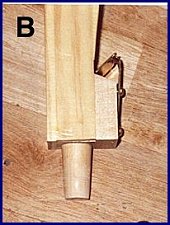 The width across the face of the pipe would be about the same as the depth
from front to back. However, in the violin and cello pipes the scale is
small in comparison to the flute pipes. That is to say, the width is
somewhat narrow when compared to the depth for a flute pipe of similar
pitch. In addition, a device known as a harmonic brake is added at the
mouth of the pipe.
The width across the face of the pipe would be about the same as the depth
from front to back. However, in the violin and cello pipes the scale is
small in comparison to the flute pipes. That is to say, the width is
somewhat narrow when compared to the depth for a flute pipe of similar
pitch. In addition, a device known as a harmonic brake is added at the
mouth of the pipe.
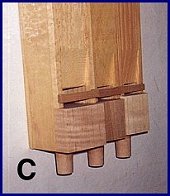 The characteristic tone of an instrument is determined
by the number of harmonics and their relative strength. The tone of the
orchestral violin consists of the fundamental plus a generous supply of
harmonics both odd and even and in order to make an organ pipe with a
violin-like tone, it is necessary to create these harmonics. The narrow
cross section encourages the formation of harmonics but also makes the
pipe
unstable, causing it to overblow. That is where the harmonic bridge comes
into play.
The characteristic tone of an instrument is determined
by the number of harmonics and their relative strength. The tone of the
orchestral violin consists of the fundamental plus a generous supply of
harmonics both odd and even and in order to make an organ pipe with a
violin-like tone, it is necessary to create these harmonics. The narrow
cross section encourages the formation of harmonics but also makes the
pipe
unstable, causing it to overblow. That is where the harmonic bridge comes
into play.
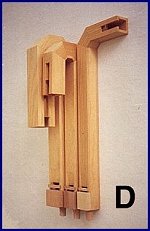 The most common type used in band organs is known as a frein
harmonique, a device patented by Gavioli in 1876. It consists of an
adjustable metal plate the lower end of which is screwed to the cap of the
pipe below the mouth. The plate is curved so that the edge of the other
end lies close to the mouth of the pipe. This prevents over blowing by
controlling the wind current at the mouth of the pipe. The frein
harmonique can be seen in PHOTO A and PHOTO B.
The most common type used in band organs is known as a frein
harmonique, a device patented by Gavioli in 1876. It consists of an
adjustable metal plate the lower end of which is screwed to the cap of the
pipe below the mouth. The plate is curved so that the edge of the other
end lies close to the mouth of the pipe. This prevents over blowing by
controlling the wind current at the mouth of the pipe. The frein
harmonique can be seen in PHOTO A and PHOTO B.
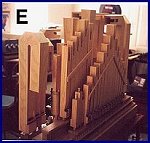 The larger, lower pitched pipes have a slightly different harmonic brake
which is made of wood which is attached across the mouth of the pipe.
PHOTO C shows the wooden harmonic brakes on the bass cello
pipes for pitches C, E, and F. The photograph is a little misleading
because all three pipes are butted up against each other and it looks as
though the brake is one long piece. However, there is a separate brake
for each of the pipes.
The larger, lower pitched pipes have a slightly different harmonic brake
which is made of wood which is attached across the mouth of the pipe.
PHOTO C shows the wooden harmonic brakes on the bass cello
pipes for pitches C, E, and F. The photograph is a little misleading
because all three pipes are butted up against each other and it looks as
though the brake is one long piece. However, there is a separate brake
for each of the pipes.
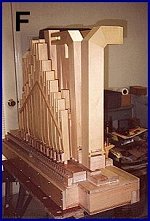 In the Wurlitzer 105 there are 28 pipes of this type, 14 melody violins, 9
cello accompaniment, and 5 bass cellos. It might be appropriate to
mention
at this time that the melody violins and accompaniment cellos are mounted
in the organ with their mouths facing the rear of the organ. In the case
of the accompaniment pipes this probably serves the purpose of keeping the
volume level below that of the melody.
In the Wurlitzer 105 there are 28 pipes of this type, 14 melody violins, 9
cello accompaniment, and 5 bass cellos. It might be appropriate to
mention
at this time that the melody violins and accompaniment cellos are mounted
in the organ with their mouths facing the rear of the organ. In the case
of the accompaniment pipes this probably serves the purpose of keeping the
volume level below that of the melody.
In addition, for both ranks it makes the pipes somewhat easier to tune by reaching in from the rear of the organ to adjust the tuning slide. Construction is basically the same as for the flageolets however there is no nodal hole in the violins and cellos. The tuning slide is fitted into slots in the same way as in the flageolets. Here is the procedure I used for voicing the violins. After the windway has been filed to the correct gap I fitted the pipe without the frein into an opening in the windchest and adjusted the pressure to the correct level. While sounding the pipe I adjusted the cap up and down slightly to achieve a good solid tone. At this point the pipe will most likely have a pitch an octave above the desired pitch. I then glued the cap in this position and then attached the frein to the cap and while the
pipe was sounding the position of the frein was adjusted by sliding it up
and down in its slotted screw holes and also in and out by turning the
upper screw clockwise or counterclockwise. A position should be found
which causes the frequency or pitch of the pipe to drop back down to the
proper note and also produce a violin-like tone.
 The bass cellos are
voiced similarly except that the wooden harmonic brakes of course can only
be moved up or down and not in or out. The bass cellos serve to augment
the bass bourdons. The bourdons are closed flute pipes and as such have
only the fundamental and odd numbered harmonics. The bass cellos are
basically the same length but are open pipes and so create a fundamental
one octave higher than the bourdon plus many odd and even harmonics. The
combination of the two played together has a much richer quality than the
bourdon alone.
The bass cellos are
voiced similarly except that the wooden harmonic brakes of course can only
be moved up or down and not in or out. The bass cellos serve to augment
the bass bourdons. The bourdons are closed flute pipes and as such have
only the fundamental and odd numbered harmonics. The bass cellos are
basically the same length but are open pipes and so create a fundamental
one octave higher than the bourdon plus many odd and even harmonics. The
combination of the two played together has a much richer quality than the
bourdon alone.
In the plans I used, the drawings which indicate the mitering of the bass
cello pipes were somewhat confusing. I hope that the photographs I am
showing here will help to clear up some of that confusion. In PHOTO D
the pipe on the left is the C bass cello, the one in the
center is the E bass cello, and the one on the right is the F bass cello.
When mounted in the organ the mouths of these pipes face the rear of the
organ. This is further illustrated in PHOTO E. This photograph also
shows the melody violins on the right with their mouths facing the rear
of the windchest and just to the left of that the accompaniment cellos
can be seen. Also note the positions of the tuning
slides. For the E pipe in the center the tuning slot will need to be in
the back side of the pipe before mitering in order for it to end up in the
position shown. For the C pipe the tuning slot will need to be in the
right side of the pipe before mitering. I also found that the dimensions
given for the spacing between holes for the pipe feet for these three
pipes
put the holes too close together to be able to fit the pipes in without
interference between them and I had to remake the riser that these pipes
fit into.
 PHOTO F shows the G bass cello with its mouth
pointed toward the left side of the organ. One can see in this picture
that as the pipe rises from the windchest it is mitered toward the front
of
the organ and then in PHOTO G one can see how it is then
mitered so that it extends across the top front of the organ. The D bass
cello can be seen next to the G bass cello with its mitered top. The G
bass cello will not fit into the case if the dimensions given in the plan
are used. Fortunately I realized this before I mitered the pipe and was
able to calculate the dimensions that would work. And finally, the
windchest with its pipes in place is shown in PHOTO H.
PHOTO F shows the G bass cello with its mouth
pointed toward the left side of the organ. One can see in this picture
that as the pipe rises from the windchest it is mitered toward the front
of
the organ and then in PHOTO G one can see how it is then
mitered so that it extends across the top front of the organ. The D bass
cello can be seen next to the G bass cello with its mitered top. The G
bass cello will not fit into the case if the dimensions given in the plan
are used. Fortunately I realized this before I mitered the pipe and was
able to calculate the dimensions that would work. And finally, the
windchest with its pipes in place is shown in PHOTO H.
Editors note: Howard is a retired electrical engineer and lives in
Florida. Most of his career was at the Army Night Vision and
Electro-Optics Laboratory. He became involved in mechanical music with
the purchase of a non-working player piano. As you will see in his
articles, Howard is a highly skilled craftsman. Building your own band
organ is a real accomplishment and Howard does beautiful work. Howard can
be contacted at: hwyman@tampabay.rr.com